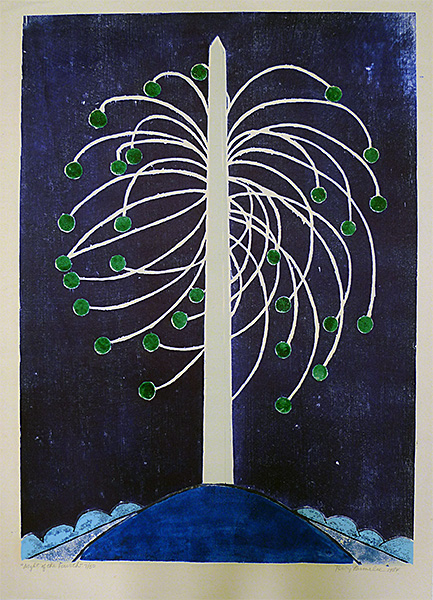
Terry Parmelee
Night of the Fourth, 1984
Woodcut on Goyu paper, 7/50
34 x 24 inches
Gift of Ingrid Rose in memory of Milton M. Rose
2012.2.3
In honor of our 240th anniversary of national independence, it is a propitious time to present a masterful woodcut in the University Art Collection. Entitled Night of the Fourth, this large-format color print was made by Washington artist Terry Parmelee in 1984. It is part of a suite of prints based on Washington monuments including the Air and Space Museum, the National Gallery of Art, and the U.S. Capitol. Night of the Fourth is an elegantly spare image of exploding fireworks surrounding the Washington Monument, an event we all anticipate whether heading to the National Mall, a local fireworks display, or settling in at home to watch a live broadcast. This print celebrates patriotic sentiments Parmelee experienced while living abroad, first in Tokyo in the 1950s, and then in Guinea the following decade. Her husband was posted to both countries, first with the Department of State, and later with the US Agency for International Development.
While living in Tokyo, Parmelee was fortunate to meet and study with the preeminent woodcut master Un’ichi Hiratsuka, the leading printmaker of the sōsaku hanga (“creative prints”) movement in 20th Century Japan. Hiratsuka moved to Washington, D.C. in 1962 and lived here thirty two years during which he taught and influenced a number of artists. He was commissioned by the government to create woodblock prints of national landmarks including the Washington Monument, and received the Order of Cultural Merit from the Japanese government in 1970.
According to Parmelee, who began as a painter, she wouldn’t have transitioned into printmaking without the influence of West Coast artist Carol Summers, who happened to be teaching at the Center for American Students and Artists in Paris when Parmelee enrolled there during the summer of 1966. Summers taught her to combine an innovative paper staining technique together with the traditional Japanese woodcut method to create saturated colors rendered in flattened shapes and forms. The primacy of color has always guided Parmelee’s work, which emerged during the Washington Color School movement of the 1960s and 70s. During this time a small group of local painters including Kenneth Noland, Morris Louis, Gene Davis and Paul Reed created vibrant abstractions on unprimed, stained canvas rendered in sharp, geometric shapes. Like the canvases of these painters, Summers’ staining technique created an intensely saturated support which exploited color for its own effects. The technique involved rolling ink thinly onto the back or front of Japanese Goyu paper, then spraying with a solvent which forces the ink to flow into the paper instead of merely sitting on the surface.
Night of the Fourth began with printing the single wood block monument in relief, then rolling and spraying the deep blue background. In this edition of 50, the blocks were printed first then the rolled ink and solvent were applied to create the night sky. Parmelee worked over the course of one long summer at the Discover Graphics Workshop at the Torpedo Factory Art Center in Alexandria, Virginia, creating the edition.
A catalogue raisonné of Parmelee’s prints was published in 1999 about the time she ceased creating woodcuts, devoting her attention to painting thereafter. The introduction to the catalog was written by Georgetown’s former print curator, Rev. Joseph A. Haller, S.J., a champion of Parmelee’s who, after visiting her studio, recognized the need to publish a guide to her “spectacular oeuvre.” The catalogue also includes essays by Sylvan Cole, director of the Associated American Artists Gallery in New York where Ms. Parmelee exhibited her work, and also by Washington gallerist Jane Haslem, who featured Parmelee in a solo exhibition in 1993. Father Haller acquired fourteen of Parmelee’s prints including the fifth woodcut in the Washington series, published on the cover of the Washington Print Club Quarterly in 1984. Night of the Fourth was generously donated by Ingrid Rose in memory of her husband, Milton, in a group of fifty-one prints by local artists. We look forward to presenting another Parmelee woodcut in the forthcoming exhibition Color in Relief, opening August 31st at Georgetown University Library.
Until then, Happy Birthday, America!
LuLen Walker, Curator, University Art Collection
July 1, 2016
